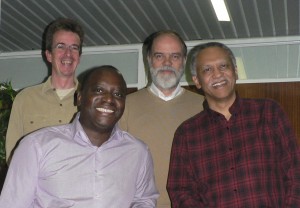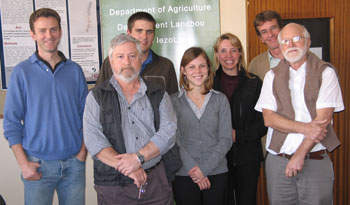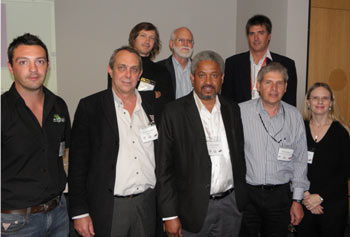Faculty of Health Sciences boasts two new Centres of Excellence

Members of the Faculty who will be responsible for the ANDI centres were congratulated by the dean, Prof Jimmy Volmink. In the front are Profs Jean Nachega (left) and Jimmy Volmink and at the back are Profs Wolfgang Preiser with Paul van Helden.
Two Centres of Excellence in Health Innovation were awarded to the Faculty of Health Sciences of Stellenbosch University by the African Network for Drugs and Diagnostics Innovation (ANDI).
The Centre for Infectious Diseases (CID) has been selected as the ANDI Centre of Excellence for HIV Translational Research and the Department of Biomedical Sciences will host a Centre of Excellence in TB Translational Research.
ANDI's main activity has been encouraging African institutions "to be recognised as centres of excellence" which brings "the opportunity to become future ANDI centres for health innovation and further capacity development in Africa". These centres will be expected to participate in the implementation of ANDI projects which will be linked to capacity building as well as stimulation of intra-African collaboration and networking.
The first group of 32 ANDI Centres of Excellence in health innovation in Africa were announced at the 4th ANDI Stakeholders Meeting and Donor Conference which took place in October at the United Nations Conference Centre in Addis Ababa, Ethiopia.
"We are very honoured and grateful for such recognition and continuing with our multi-disciplinary team work spirit at CID, we look forward to working with ANDI and contributing to HIV translational research by filling the gap between bench and clinical/epidemiological HIV research," said Professor Jean Nachega, Director of CID at SU-FHS.
Professor Wolfgang Preiser, Head of the Medical Virology Division at SU-FHS, said that they are excited and grateful for this opportunity to participate in ANDI. "The goal of providing universal access to HIV treatment across Africa urgently requires affordable and practical yet high quality diagnostic tools. We look forward to helping develop and evaluate such tests in co-operation with ANDI partners."
Eleven of the 32 ANDI Centres Of Excellence were awarded to South African institutions, of which 8 are situated in the Western Cape, namely Stellenbosch University (2), the SA Medical Research Council (1), University of Cape Town (3), iThemba Labs (1), and the Council for Scientific and Industrial Research (1). The other 3 are in Gauteng at the University of Witwatersrand (2) and iThemba Pharmaceuticals (1).
The African Network for Drugs and Diagnostics Innovation (ANDI) was created in 2008, with funding from the European Union and other stakeholders, to build research capability and leadership in Africa in order to scale up research aimed at discovering and developing new and improved tools to address the diseases that disproportionately affect the African continent.
---------------------------------------------------------------------------------------------------------------------------------------------------------------------
"One Health" seminar on Avian Influenza held on the 19th of August 2011 in the Division of Medical Virology, Stellenbosch University
After avian flu ravaged several farms in the Little Karoo region of South Africa, a flock of trained ostriches were destroyed after contracting the disease. The ostriches were a tourist attraction at the Highgate farm where visitors have been riding the birds for more than 80 years. The farm is near Oudtshoorn South Africa, the main town of the region. "I'm an ostrich farmer without ostriches," farm owner Arenhold Hooper told The Times in Johannesburg. He said the farm laid off 39 employees since the flock was culled in June 2011. Thousands of ostriches have been culled since the first reported case of avian flu in April, with further losses expected as the epidemic spreads. Read more...
 The speakers and organizers of the "One Health" seminar on Avian Influenza held on the 19th of August 2011 in the Virology Division: Prof Graeme Cumming, Dr Pieter Koen, Dr Lesley van Helden, Dr Annelie Cloete, Prof Wolfgang Preiser and Dr Neil Cameron
The speakers and organizers of the "One Health" seminar on Avian Influenza held on the 19th of August 2011 in the Virology Division: Prof Graeme Cumming, Dr Pieter Koen, Dr Lesley van Helden, Dr Annelie Cloete, Prof Wolfgang Preiser and Dr Neil Cameron
Talks described the current outbreak of highly pathogenic avian influenza (HPAI - H5N2) epidemic in the Oudtshoorn area and the vigorous systematic response by the Animal Health Division of the Dept of Agriculture, the ongoing HPAI - H5N1 epidemic in Asia and Eastern Mediterranean region and H5N1 in humans and other flu viruses of this season.
"One Health" is joint effort of the Veterinary Services, Dept of Agriculture; Percy FitzPatrick Institute of African Ornithology, University of Cape Town; and the Divisions of Virology (NHLS) and Community Health of the University of Stellenbosch under the auspices of the Centre for Infectious Diseases (CID).
1. Current outbreak of Highly Pathogenic H5N2 in Western Cape Ostriches -John Grewar-August 2011.
A description of the sequence of events with regards to the recent Avian Influenza H5N2 outbreak, which prompted the Western Cape Department of Agriculture to set up a Veterinary Control Centre in Oudsthoorn, was given. The case definition for the outbreak's AI infections included lab and clinical/epidemiological variables. The outbreak occurred in a ostrich dense area in the Western Cape Province and a description of the current Avian Influenza Control Area (AICA) was given. Following the confirmation of highly pathogenic avian influenza (HPAI) numerous rounds of surveillance have taken place within and outside of the AICA. These rounds have identified a total (as of 15 Aug 2011) of 34 positive farms, with all but 1 within the AICA. Also given was an indication of the planned surveillance to be done within the AICA. As of the date of the talk the infection was still active within the AICA but an application to the European Union for possible export from outside the AICA was being planned.
2. Control of Avian Influenza outbreaks in Ostriches - Pieter Koen (Veterinary Services, Dept of Agriculture)
The control of this disease has resulted in a major campaign being launched in the Klein Karoo Valley. Animal Health Technicians and State Veterinarians had to be drafted into the area to assist with surveillance, informatics and epidemiology, movement control and killing and disposal. Planning of surveillance was greatly assisted by spatial data and maps of the relevant areas. During the initial round of surveillance there were severe bottle necks with respect to diagnostic laboratory capacity, especially PCR capacity. This was addressed by utilising a range of laboratories, both State and privately run to shorten turnaround times to expedite detection and control and minimise transmission. Adverse weather conditions such as heavy rains resulting in floods, road closures and extremely uncomfortable and dangerous outside working conditions taxed field staff to the utmost. Notwithstanding these challenges the campaign progressed well. Detection and control is still ongoing as new infections are constantly being detected, probably sparked by the cold and wet resulting in long virus survival. The presentation attached reflects the statistics of this eradication campaign thus far.
3. Current situation of N5N1 globally in birds -Lesley van Helden (Veterinary Services, Diesease Control, Dept of Agriculture)
H5N1 in 2011 has directly caused the deaths of approximately 200 000 poultry and indirectly, as a result of culling, 4.3 million poultry worldwide. Countries affected lie predominantly in South-East Asia, but Egypt is also an important location, where the disease has been declared endemic. Outbreaks tend to follow a pattern of peaking in the winter months of the northern hemisphere, which is consistent with current theories of spread, such as movement of migratory birds and increased trade in live poultry. Various methods of control are being used in each affected country, and each location has difficulties unique to their situation.
4. Wild Bird flight paths and risks for A1 transmission - Graeme Cumming (Percy FitzPatrick Institute of African Ornithology, UCT)
I presented two sets of results from our ongoing research on wild birds and low pathogenic avian influenza. (1) The first set consisted of known prevalence's of AI in wild birds across our five different study sites: Strandfontein (W Cape), Barberspan (NW Province), Lakes Chivero and Mayame (Zimbabwe), Lake Ngami (Botswana) and Lake Chuali (Mozambique). The overall prevalence of LPAI viruses in wild birds in southern Africa is around 2.5%, with considerable spatial and temporal variation. Unexpectedly high prevalences (3-5%) were found in White-faced Duck, African Jacana, and some passerine groups. (2) The second set of results consisted of a brief summary of results from satellite telemetry of Red-billed Teal and Egyptian Geese, which we identified a priori as two of the higher-risk species for AI transmission. Our data suggest that Egyptian Geese in particular may move long distances during moult migrations (e.g., one individual went over a thousand kilometres in two days), making it extremely difficult to control AI in wild bird populations. Wild bird movements do however have some predictable elements relating to their life histories and moulting needs, and we hypothesize that ultimately the epidemiology of LPAI is driven by a combination of rainfall and the aggregated outcomes of seasonal bird movements.
5. H5N in humans and other flu viruses of this season - Wolfgang Preiser (Virology, NHLS & SU)
"Birds are probably the origin of all influenza viruses, some of which established themselves in other animal species including human beings. Direct transmission of avian influenza viruses to humans has been described but normally results in no or only mild disease; a notable exception is HPAI H5N1 which has killed more than half those infected. The HPAI H5N2 currently affecting ostriches in South Africa may cause human infections but so far the few cases described have been very mild. Nevertheless recommended precautions should be taken."
---------------------------------------------------------------------------------------------------------------------------------------------------------------------
National Legionnaires' Disease Symposium 2011

From left: Alan Sanderson (Ecosafe), Ivan Bromfield (City Health), Jantjie Taljaard (US & TBH), Neil Cameron (US), Frew Benson (National Health), Ian Gildenhuys (City Health), Rob Stewart (NHLS), Juno Thomas (NICD/ NHLS). Absent: Andy Cunningham (PGWC), Andrew Gartshore (Westin Grand), Adele Baleta (Media Consultant) and Murdock Ramathuba (National Health).
Photo: Dr Bart Willems
A Legionnaires Disease Symposium organized by the Centre for Infectious Diseases of the Faculty of Health Sciences, Stellenbosch University with the help of the Health Department of the City of Cape Town in the Civic Center on the 12th of May 2011. National experts in fields ranging from senior staff of the National Department of Health, environmental health practitioners, microbiologists, risk assessment consultants, infectious disease clinicians, hospital and hotel and a media consultant spoke at the symposium which was chaired by Dr Bromfield the Executive Director of the City Health Department and Dr Cameron of the Centre for infectious Diseases.
Legionellae are common organisms found in many open water sources and tend to exploit man-made aquatic systems. The organisms are spread to humans through the inhalation of aerosols of contaminated water from hot water systems (showers), air conditioning towers, evaporative condensers, whirlpool spas, decorative fountains, respiratory therapy and wastewater treatment plants for wood, paper, petroleum and sewage.
Legionellae grow best at temperatures between 25 - 40oC and survive adverse conditions in biofilms. Biofilms are aggregations of microorganisms and protozoa which adhere to each other along surfaces in aquatic environments especially in dead-leg pipes.
Outbreaks are often linked to high-rise buildings hospitals, hotels, old age homes, schools and cruise ships, and so tend to be newsworthy and costly.
Legionella pneumonia cause occasional outbreaks of flu like illness, progressing to toxicity with high fever with gastrointestinal symptoms and pneumonia. People over 50 and those immune compromised are more at risk. The mortality rate in hospital is high if not treated with the appropriate antibiotics. Incorrect laboratory sampling and testing complicates identification, diagnosis and management. Good environmental control is an essential part of managing the risk of Legionnaires' disease especially hospitals and hotels. A major international hotel group is currently being sued for millions of US dollars by the family of a man who died from legionnaires' disease after sleeping over in one of their hotels.
>>Legionella History, Environment & Microbiology - Rob Stewart NHLS Infections Control Service Lab
>>Legionellosis Clinical Picture & Treatment - Jantjie Taljaard Stellenbosch University
>>Legionnaires Disease Case Investigation An Enviromental Health Perspective form the City of Cape Town - Ian Gildenhuys
>>Legionnaires Disease Hospital Engineering Perspective - Andy Cunningham
>>Practical Legionella Risk Management A South African Perspective- Alan Sanderson Ecosafe
>>Legionnaires Disease Laboratory Diagnosis, Epidemiology and Outbreak response - Dr Juno Thomas
>>Legionella Policy Development Environmetal and Health Perspective - Murdock Ramathuba
---------------------------------------------------------------------------------------------------------------------------------------------------------------------
SU receives a $10 million grant from the USA for medical education and research training
Medical education and research training in South Africa received a $10 million boost when Stellenbosch University was included as recipient in a multimillion dollar United States project to build capacity in the field of medical education in sub-Saharan Africa.
The United States (US) Department of Health and Human Services, in partnership with the US President's Emergency Plan for AIDS Relief (PEPFAR) will invest $130 million over five years to transform African medical education and dramatically increase the number of professional health care workers in Africa.
The Medical Education Partnership Initiative (MEPI) programme was designed to support PEPFAR's goal to train and retain 140 000 new health care workers and improve the capacity of partner countries to deliver primary health care.
Through the MEPI, grants have been awarded directly to African institutions in a dozen countries, working in partnership with medical schools and universities in the USA. The initiative will comprise a network that includes some 30 regional partners, country health and education ministries, and more than 20 US collaborators.
MEPI is a collaborative venture involving the US Office of the Global AIDS Coordinator, Health Resources and Services Administration (HRSA), and the National Institutes of Health (NIH)'s Fogarty International Centre. The All-MEPI Coordinating Centre has been awarded to George Washington University, and led by Dr. Fitzhugh Mullan and Dr. Seble Lemma.
As a recipient of one of the MEPI grants, the Stellenbosch University's Rural Medical Education Partnership Initiative (SURMEPI) will receive $2,000,000 each year over a five year period, totalling $10,000,000 over five years.
"The Stellenbosch University team is honoured and gratified by the trust inspired by our research and training capacity. Many of our researchers work at well-established research sites within urban and rural communities, while others are involved in cutting-edge laboratory research. Bringing innovative medical knowledge and the skills in a rural setting where it is most needed with the contribution of clinical and public health grassroots investigations made our application innovative, competitive and at the end of the day successful. " says Professor Jean Nachega, Director: Centre for Infectious Diseases Faculty of Health Sciences, Stellenbosch University and Principal Investigator of the recently awarded SURMEPI Grant.
The funding will be applied to build capacity in medical education and research training initially at Rural Clinical School located in Worcester and then expanding to other rural sites. The specific proposed projects and their leaders are:
- Clinical Competency on Antiretroviral and Tuberculosis Treatment for health professionals (nurses, doctors, pharmacists, etc.)(Prof Nikodem, Dr. Jantjie Taljaard);
- Evidence-Based Medicine (Dr. Taryn Young and Prof Jimmy Volmink);
- Health System Science Research (Profs Lilian Dudley and Merrick Zwarenstein);
- Pharmacology (Prof Bernd Rosenkranz);
- Epidemiology, Biostatistics and Public Health (Dr. Neil Cameron and Prof Jean Nachega) ;
- Infection Prevention and Control (Prof Shaheen Mehtar);
- Infectious Diseases Training (Dr. Jantjie Taljaard and Prof Jean Nachega);
- Family-Based Model of HIV Care (Prof Mark Cotton)
- Core Rural Clinical School (Prof Marietjie De Villiers and Dr Therese Fish).
In terms of the grant, Stellenbosch University will be collaborating with a number of external health institutions, including the Johns Hopkins University in USA; Makarere University in Uganda; the University of Cape Town's Lung Institute's Knowledge Translation Unit; and the Karolinska Institute in Sweden.
- A complete list of MEPI awards and collaborating partners is available here.
---------------------------------------------------------------------------------------------------------------------------------------------------------------------
CID Members Contribute to TB Text book
The Book "Tuberculosis: A comprehensive clinical reference" edited by Schaaf & Zumla was published recently. Prof Simon Schaaf pointed out that "A number of the CID people have contributed to the book for which I am very grateful". There were 25 people involved from our Faculty: Nulda Beyers, Robert Gie, Ben Marais, Anneke Hesseling, Simon Schaaf, Peter Donald, Sharon Kling, Pierre Goussard, Johan Schoeman, Etienne Nel, Jean Nachega, Juanita Bezuidenhout, Colleen Wright, Johann Schneider, Paul v Helden, Chris McEvoy, Rob Warren, Francois Jordaan, Gert Vlok, Martin Storm, Matthys Botha, H van der Merwe, Donald Enarson, Madhu Pai (last two honorary profs SU) Helmuth Reuter, Elvis Irusen.
There are two editions of the book with exact same contents published by Saunders, Elsevier. The Europe/USA version is hard cover, but better quality paper and costs about 3 times that of the Indian edition which is also hard cover and still good quality paper R650-R700 and is available in South Africa. The book can be ordered through Jackie Strydom from Medbookseller in Durbanville e-mail: Jackie@medbookseller.co.za and telephone 021-9751970/083-3038500.

